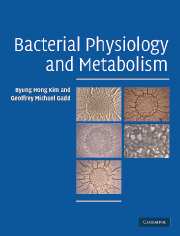Book contents
- Frontmatter
- Contents
- Preface
- 1 Introduction to bacterial physiology and metabolism
- 2 Composition and structure of prokaryotic cells
- 3 Membrane transport – nutrient uptake and protein excretion
- 4 Glycolysis
- 5 Tricarboxylic acid (TCA) cycle, electron transport and oxidative phosphorylation
- 6 Biosynthesis and microbial growth
- 7 Heterotrophic metabolism on substrates other than glucose
- 8 Anaerobic fermentation
- 9 Anaerobic respiration
- 10 Chemolithotrophy
- 11 Photosynthesis
- 12 Metabolic regulation
- 13 Energy, environment and microbial survival
- Index
- References
4 - Glycolysis
Published online by Cambridge University Press: 05 September 2012
- Frontmatter
- Contents
- Preface
- 1 Introduction to bacterial physiology and metabolism
- 2 Composition and structure of prokaryotic cells
- 3 Membrane transport – nutrient uptake and protein excretion
- 4 Glycolysis
- 5 Tricarboxylic acid (TCA) cycle, electron transport and oxidative phosphorylation
- 6 Biosynthesis and microbial growth
- 7 Heterotrophic metabolism on substrates other than glucose
- 8 Anaerobic fermentation
- 9 Anaerobic respiration
- 10 Chemolithotrophy
- 11 Photosynthesis
- 12 Metabolic regulation
- 13 Energy, environment and microbial survival
- Index
- References
Summary
Escherichia coli can grow on a simple medium containing glucose and mineral salts and this bacterium can synthesize all cell constituents using materials provided in this medium. Glucose is metabolized through the Embden–Meyerhof–Parnas (EMP) pathway and hexose monophosphate (HMP) pathway and the metabolic product, pyruvate, is decarboxylated oxidatively to acetyl-CoA to be oxidized through the tricarboxylic acid (TCA) cycle. Twelve intermediates of these pathways are used as carbon skeletons for biosynthesis (Table 4.1). Heterotrophs that utilize organic compounds other than carbohydrates convert their substrates into one or more of these intermediates. For this reason, glucose metabolism through glycolysis and the TCA cycle is called central metabolism.
Eukaryotes metabolize glucose through the EMP pathway to generate ATP, pyruvate and NADH, and the HMP pathway is needed to supply the metabolic intermediates not available from the EMP pathway such as pentose-5-phosphate and erythrose-4-phosphate, and NADPH. Most prokaryotes employ similar mechanisms, but some prokaryotes metabolize glucose through unique pathways known only in prokaryotes, e.g. the Entner–Doudoroff (ED) pathway and phosphoketolase (PK) pathway. Some prokaryotes have genes for the ED pathway in addition to the EMP pathway: genes for these pathways are expressed at the same time in several prokaryotes including a thermophilic bacterium (Thermotoga maritima), a thermophilic archaeon (Thermoproteus tenax) and a halophilic archaeon (Halococcus saccharolyticus). Escherichia coli metabolizes glucose via the EMP pathway, but gluconate is oxidized through the ED pathway. Modified EMP and ED pathways are quite common in archaea.
- Type
- Chapter
- Information
- Bacterial Physiology and Metabolism , pp. 60 - 84Publisher: Cambridge University PressPrint publication year: 2008
References
- 2
- Cited by



